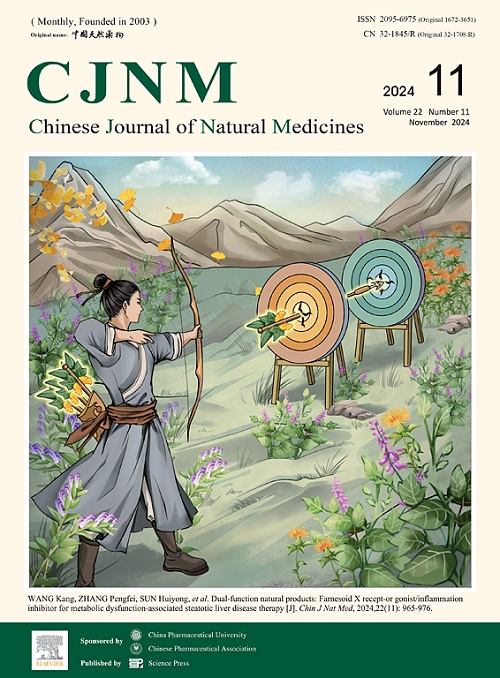caulomycin A在三阴性乳腺癌细胞中破坏葡萄糖代谢并触发内质网应激诱导的凋亡
IF 4.9
2区 医学
Q1 INTEGRATIVE & COMPLEMENTARY MEDICINE
引用次数: 0
摘要
三阴性乳腺癌(TNBC)是一种侵袭性乳腺癌亚型,预后差,靶向治疗选择有限。本研究检测了从海洋放线菌中提取的天然化合物绿霉素A (Cae A)对TNBC的抗癌潜力。Cae A通过诱导凋亡,选择性抑制TNBC细胞系(包括4T1、MDA-MB-231和MDA-MB-468)的活力和增殖。机制分析显示,该化合物诱导持续内质网(ER)应激,随后上调C/EBP同源蛋白(CHOP)表达,导致线粒体损伤介导的细胞凋亡。抑制内质网应激或CHOP表达下调可逆转线粒体损伤和凋亡,突出了内质网应激和CHOP在Cae A抗肿瘤机制中的重要作用。在Cae A治疗后,TNBC细胞的耗氧率(OCR)和细胞外酸化率(ECAR)均下降,表明线粒体呼吸和糖酵解能力降低。这种能量代谢的减少可能引发内质网应激和随后的细胞凋亡。Cae A在体内对4T1肿瘤模型有明显的抗肿瘤作用,无明显毒性。该化合物还能有效抑制人类TNBC类器官的生长。这些结果表明,Cae A可能作为TNBC的潜在治疗剂,其疗效可能通过破坏葡萄糖代谢和诱导内质网应激相关的凋亡介导。本文章由计算机程序翻译,如有差异,请以英文原文为准。
Caerulomycin A disrupts glucose metabolism and triggers ER stress-induced apoptosis in triple-negative breast cancer cells
Triple-negative breast cancer (TNBC) represents an aggressive breast cancer subtype with poor prognosis and limited targeted treatment options. This investigation examined the anti-cancer potential of Caerulomycin A (Cae A), a natural compound derived from marine actinomycetes, against TNBC. Cae A demonstrated selective inhibition of viability and proliferation in TNBC cell lines, including 4T1, MDA-MB-231, and MDA-MB-468, through apoptosis induction. Mechanistic analyses revealed that the compound induced sustained endoplasmic reticulum (ER) stress and subsequent upregulation of C/EBP homologous protein (CHOP) expression, resulting in mitochondrial damage-mediated apoptosis. Inhibition of ER stress or CHOP expression knockdown reversed mitochondrial damage and apoptosis, highlighting the essential role of ER stress and CHOP in Cae A’s anti-tumor mechanism. Both oxygen consumption rate (OCR) and extracellular acidification rate (ECAR) decreased in TNBC cells following Cae A treatment, indicating reduced mitochondrial respiratory and glycolytic capacities. This diminished energy metabolism potentially triggers ER stress and subsequent apoptosis. Furthermore, Cae A exhibited significant anti-tumor effects in the 4T1 tumor model in vivo without apparent toxicity. The compound also effectively inhibited human TNBC organoid growth. These results indicate that Cae A may serve as a potential therapeutic agent for TNBC, with its efficacy likely mediated through the disruption of glucose metabolism and the induction of ER stress-associated apoptosis.
求助全文
通过发布文献求助,成功后即可免费获取论文全文。
去求助
来源期刊

Chinese Journal of Natural Medicines
INTEGRATIVE & COMPLEMENTARY MEDICINE-PHARMACOLOGY & PHARMACY
CiteScore
7.50
自引率
4.30%
发文量
2235
期刊介绍:
The Chinese Journal of Natural Medicines (CJNM), founded and sponsored in May 2003 by China Pharmaceutical University and the Chinese Pharmaceutical Association, is devoted to communication among pharmaceutical and medical scientists interested in the advancement of Traditional Chinese Medicines (TCM). CJNM publishes articles relating to a broad spectrum of bioactive natural products, leading compounds and medicines derived from Traditional Chinese Medicines (TCM).
Topics covered by the journal are: Resources of Traditional Chinese Medicines; Interaction and complexity of prescription; Natural Products Chemistry (including structure modification, semi-and total synthesis, bio-transformation); Pharmacology of natural products and prescription (including pharmacokinetics and toxicology); Pharmaceutics and Analytical Methods of natural products.
 求助内容:
求助内容: 应助结果提醒方式:
应助结果提醒方式:


